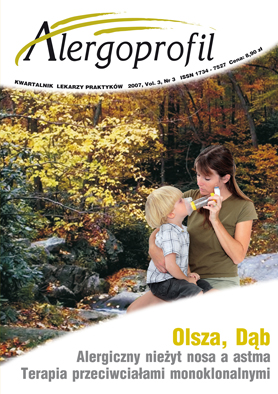Czy istnieją „dobre” alergeny?
##plugins.themes.bootstrap3.article.main##
Abstrakt
W artykule autorzy przedstawili możliwości terapeutyczne wybranych alergenów: dinitrochlorobenzenu (DNCB), difenylocyklopropenonu (DCP) oraz squaric acid dibutylester (SADBE). Zwłaszcza dwa ostatnie są bezpiecznymi i skutecznymi środkami w leczeniu łysienia plackowatego (AA, alopecia areata). W ostatnim czasie w piśmiennictwie światowym pojawiły się doniesienia, że tego typu alergeny znajdują zastosowanie również w leczeniu nowotworów.
Pobrania
##plugins.themes.bootstrap3.article.details##
Copyright: © Medical Education sp. z o.o. This is an Open Access article distributed under the terms of the Attribution-NonCommercial 4.0 International (CC BY-NC 4.0). License (https://creativecommons.org/licenses/by-nc/4.0/), allowing third parties to copy and redistribute the material in any medium or format and to remix, transform, and build upon the material, provided the original work is properly cited and states its license.
Address reprint requests to: Medical Education, Marcin Kuźma (marcin.kuzma@mededu.pl)
Bibliografia
2. Herbst V., Zöller M., Kissling S., Wenzel E., Stutz N., Freyschmidt-Paul P.: Diphenylcyclopropenone treatment of alopecia areata induces apoptosis of perifollicular lymphocytes. Eur. J. Dermatol. 2006, Sep., Oct. 16(5): 537-42.
3. Wasyłyszyn T., Kozłowski W., Zabielski S.L.: Changes in distribution pattern of CD8 lymphocytes in the scalp in alopecia areata during treatment with diphencyprone. Arch. Dermatol. Res. 2007, Aug 299(5–6): 231-7.
4. Holzer A.M., Kaplan L.L., Levis W.R.J.: Haptens as drugs: contact allergens are powerful topical immunomodulators. Drugs Dermatol. 2006, May 5(5): 410-6.
5. Paus R., Nickoloff B.J., Ito T.: A ‘hairy’ privilege. Trends Immunol. 2005, Jan 26(1): 32-40.
6. Damian D.L., Thompson J.F.: Treatment of extensive cutaneous metastatic melanoma with topical diphencyprone. J. Am. Acad. Dermatol. 2007, May 56(5): 869-71.
7. Ajith C., Gupta S., Kanwar A.J.: Efficacy and safety of the topical sensitizer squaric acid dibutyl ester in Alopecia areata and factors influencing the outcome. J. Drugs Dermatol. 2006, Mar 5(3): 262-6.

